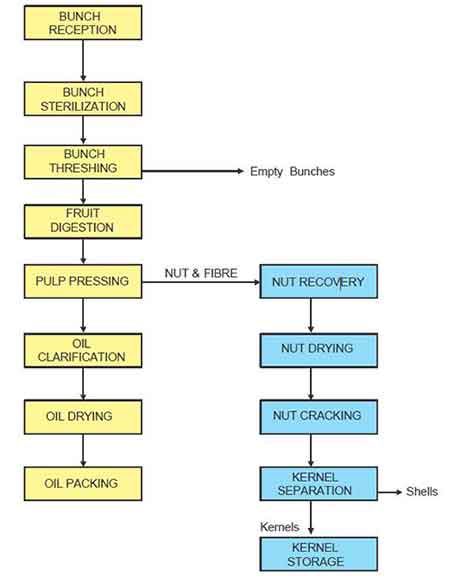Research and development work in many disciplines – biochemistry, chemical and mechanical engineering – and the establishment of plantations, which provided the opportunity for large scale fully mechanised processing for palm oil, resulted in the evolution of a sequence of processing steps designed to extract, from a harvested oil palm bunch, a high yield of a product of acceptable quality for the international edible oil trade. The oil winning process, in summary, involves the reception of fresh fruit bunches from the plantations, sterilizing and threshing of the bunches to free the palm fruit, mashing the fruit and pressing out the crude palm oil. The crude oil is further treated to purify and dry it for storage and export.
Large-scale plants, featuring all stages required to produce palm oil to international standards, are generally handling from 3 to 60 tonnes of FFB/hr. The large installations have mechanical handling systems (bucket and screw conveyers, pumps and pipelines) and operate continuously, depending on the availability of FFB. Boilers, fuelled by fibre and shell, produce superheated steam, used to generate electricity through turbine generators. The lower pressure steam from the turbine is used for heating purposes throughout the factory. Most processing operations are automatically controlled and routine sampling and analysis by process control laboratories ensure smooth, efficient operation. Although such large installations are capital intensive, extraction rates of 23 – 24 percent palm oil per bunch can be achieved from good quality Tenera.
Conversion of crude palm oil to refined oil involves removal of the products of hydrolysis and oxidation, colour and flavour. After refining, the oil may be separated (fractionated) into liquid and solid phases by thermo-mechanical means (controlled cooling, crystallization, and filtering), and the liquid fraction (olein) is used extensively as a liquid cooking oil in tropical climates, competing successfully with the more expensive groundnut, corn, and sunflower oils.
Extraction of oil from the palm kernels is generally separate from palm oil extraction, and will often be carried out in mills that process other oilseeds (such as groundnuts, rapeseed, cottonseed, shea nuts or copra). The stages in this process comprise grinding the kernels into small particles, heating (cooking), and extracting the oil using an oilseed expeller or petroleum-derived solvent. The oil then requires clarification in a filter press or by sedimentation. Extraction is a well-established industry, with large numbers of international manufacturers able to offer equipment that can process from 10 kg to several tonnes per hour.
Alongside the development of these large-scale fully mechanised oil palm mills and their installation in plantations supplying the international edible oil refining industry, small-scale village and artisanal processing has continued in Africa. Ventures range in throughput from a few hundred kilograms up to 8 tonnes FFB per day and supply crude oil to the domestic market.
Efforts to mechanise and improve traditional manual procedures have been undertaken by research bodies, development agencies, and private sector engineering companies, but these activities have been piecemeal and uncoordinated. They have generally concentrated on removing the tedium and drudgery from the mashing or pounding stage (digestion), and improving the efficiency of oil extraction. Small mechanical, motorised digesters (mainly scaled-down but unheated versions of the large-scale units described above), have been developed in most oil palm cultivating African countries.
Palm oil processors of all sizes go through these unit operational stages. They differ in the level of mechanisation of each unit operation and the interconnecting materials transfer mechanisms that make the system batch or continuous. The scale of operations differs at the level of process and product quality control that may be achieved by the method of mechanisation adopted. The technical terms referred to in the diagram above will be described later.
The general flow diagram is as follows:

PALM OIL PROCESSING UNIT OPERATIONS
